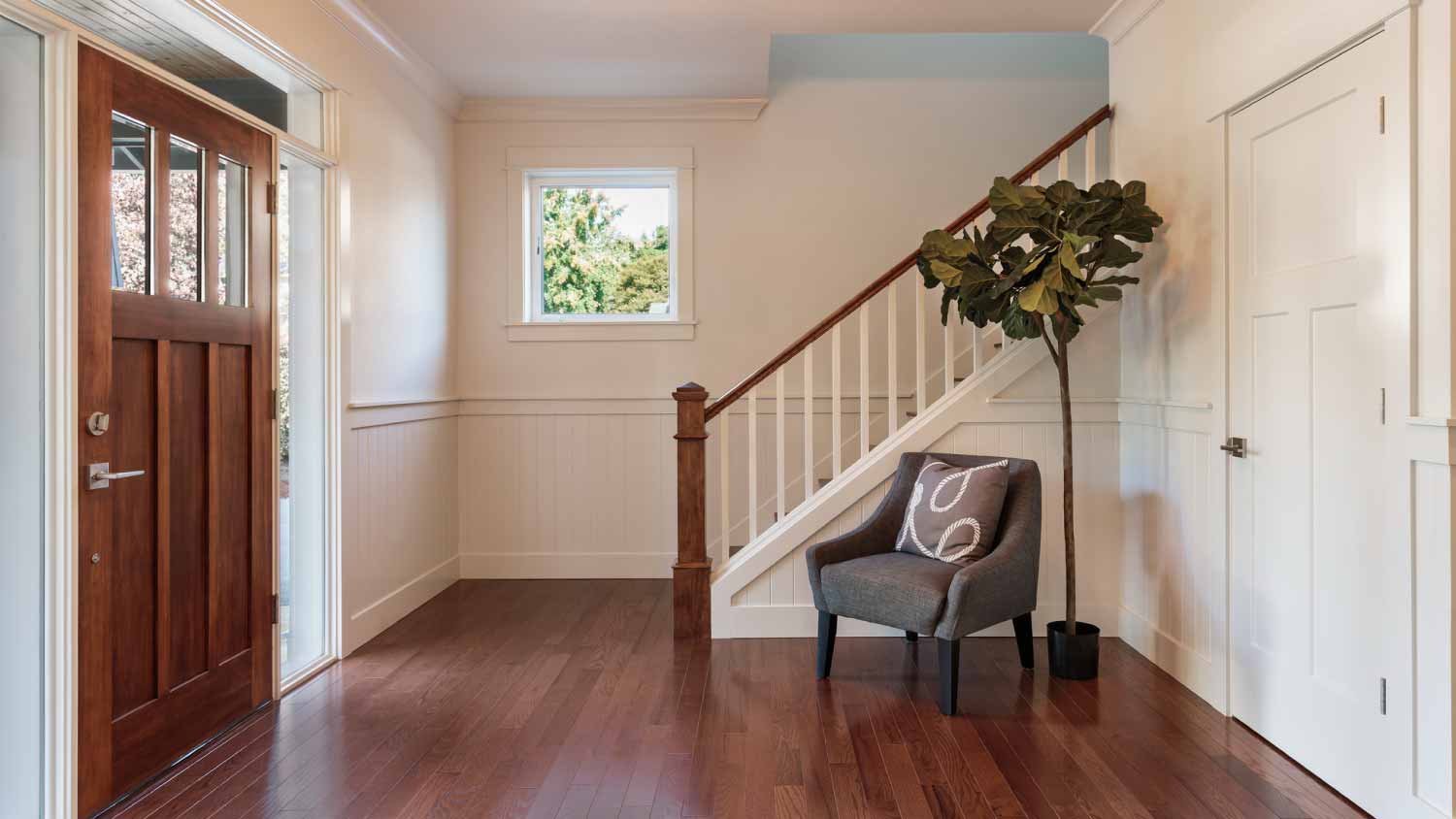What Types of Flooring Can Be Installed Over Ceramic Tile?
Installing flooring over ceramic can transform the look of your entire room


After one too many long nights in the kitchen, you have convinced yourself it is time to opt for something more comfortable than ceramic tiles. But rather than breaking down and removing the flooring, you can save time and money by installing another type of flooring right on top of your existing ceramic tiles. Here are all the options for flooring that will fit perfectly on top of your tiles.
1. Ceramic Tile
It may sound counterintuitive to install ceramic tile over ceramic tile, but if your only gripe with the tile is its pattern design, rather than its feel, then this is a possibility. Before you begin, you should do a thorough inspection for any signs of mildew or discoloration. Any signs of either mean there could be an absorption issue that will only worsen if you re-tile on top of the problem. If you see signs of water damage or mold, hire a mold removal service to tackle the problem before it gets worse. Assuming those problems are absent, prepare the surface by leveling out any uneven areas of grout and repairing loose tiles before installing the new layer.
2. Vinyl
Typically, higher quality vinyl flooring does not require the use of an underlayment, so you will mostly keep your floor’s height the same. Keep in mind that sheet vinyl flooring and vinyl tiles are thinner than vinyl plank flooring.
If, however, your tiled floor has radiant heating, you may need to install floating vinyl planks, since the other options use an adhesive that cannot withstand higher temperatures. Do keep that in mind when looking for flooring you can put over ceramic tile. In addition, vinyl plank flooring is extremely waterproof, making it a great choice in bathrooms, kitchens, and laundry rooms.
3. Laminate
Laminate flooring is inexpensive and very easy to install, and it has padding underneath that can mask any unevenness on the base layer of tile. It does not require any adhesive, making it easy to remove, should you ever change your mind. If your ceramic tile has radiant heating, laminate flooring is a good option, as long as you acclimate the floor to the floor’s temperature for at least 48 hours before installing.
4. Engineered Wood

Solid wood is not a great option as it requires a plywood subfloor before installation. That plus the thickness of the wood (¾-inch) will more often than not make the flooring too thick. A better option is engineered wood, which is much thinner than solid wood and can be glued directly onto the tile without the need for an additional subfloor, making installation easy. Furthermore, you can still feel a radiant heating source through engineered wood flooring if one exists.
5. Carpet
Carpet is sold in a range of heights, so you can probably find a style that will not interfere with your doors or other fixtures in the room. That said, it needs to be applied with epoxy that can stain your tiles, though you can opt only to fasten it in the corners, impacting as few tiles as possible. Since carpet absorbs water and stains easily, it is not something you want in your bathroom or kitchen, but it does absorb sound better than any other option on this list, which might make it a good choice for a den or kid’s room. If your ceramic tile has radiant heating, you may also consider carpeting, but talk to your sales professional about the proper padding type to ensure you can feel the heat through the carpeting.
6. Cork
Cork is water resistant, making it a great option in kitchens and bathrooms. It is highly durable, comfortable, warm, and does not echo foot traffic. Cork is also eco-friendly, made entirely from renewable resources, and fully biodegradable. However, be aware that cork can fade in direct sun. This makes it most useful in bathrooms that typically do not have as many windows with direct sunlight.
Most contractors suggest not installing cork flooring over ceramic tiles with radiant heat because cork flooring is naturally insulated and typically does not need the help of an additional heat source to feel cozy. When installing cork over ceramic, apply a patching cement first to eliminate deflections and grout lines.
High-traffic areas require flooring that can withstand frequent use, children’s shoes, scurrying paws, and dirt or stains. Installing an easy-to-clean floor that will last on stairs, hallways, or in the kitchen may be worth the long-term investment.
When Do I Need to Remove Ceramic Tiles?
Certain circumstances may necessitate the need to remove your ceramic tiling completely. If several tiles are cracked or loose, it may be time to remove all of them so you can take a peek at the subfloor and see if any deeper issues are going on there.
If you notice any signs of water damage or mold, you should have the tile removed and investigate the extent of the damage. Mold can spread quickly and become a much bigger and very costly problem.
Also, if the new flooring laid over ceramic tiles makes the floor too high, it could cause problems with your existing cabinets. Removing the old tiles allows more room and avoids the issue of needing new cabinetry or losing space in your existing cabinets.
Removing ceramic tiles is a delicate process, especially if you want to repurpose any of the existing tiles, so we recommend hiring a flooring professional to get the job done correctly. It is especially important to hire a professional if you must remove ceramic tile with radiant heating as this is a complicated process that, if not handled properly, could damage the heating source.
DIY New Flooring Over Tile Installation vs. Hiring a Pro
The types of flooring you choose to put over ceramic tile will affect whether you go the DIY route or hire a pro. Some flooring types, such as vinyl plank or luxury vinyl tile, are great for DIY projects, whereas other flooring types, like hardwood or natural stone, are best left to the pros.
Whether you should install flooring yourself or hire a pro also depends on the condition of the tile underneath. For example, if there is mold or mildew growth, or if the tile has radiant heating, further steps are necessary to ensure the new floor’s stability and longevity. This job is best left to the pros. Depending on the type, the average cost to install new flooring is $5 to $25 per square foot, but you would need to find a professional flooring company near you to obtain more precise estimates.

.jpg?impolicy=leadImage)



- What Is the Best Tile for Bathroom Floors?
- Ceramic Tile Flooring Pros and Cons: Could This Be the Tile of Your Dreams?
- How Long Does Tile Flooring Last?
- 11 Types of Flooring to Consider for Your Home
- What’s the Best Flooring for Bathrooms? Here Are 5 Durable Picks
- Should You Install a Tile Floor Before or After Cabinets?
- 15 Great Options for Budget-Friendly Kitchen Floors
- 7 Budget-Friendly Kitchen Flooring Options for Every Style
- Keep Moisture at Bay With These 5 Waterproof Flooring Options
- Porcelain vs. Ceramic Tile: Which Is Best for Your Home?











